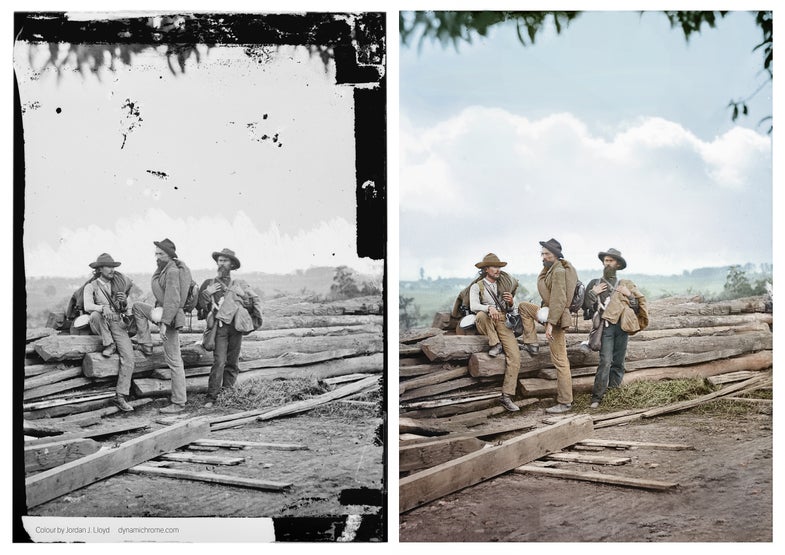We may earn revenue from the products available on this page and participate in affiliate programs. Learn more ›
Photographs from the American Civil War have a funereal air to them. Add color to these historical artifacts, and a weird thing happens: they spring to life. And in doing so, they almost seem more mundane. Jordan J. Lloyd, of digital image restoration company Dynamichrome, has added color to a selection of Civil War photographs. Consider it a reverse Instagram–rather than filter modern images through the amber lens of the past, Lloyd strips away all the nostalgia, leaving pictures that just feel strangely normal.
Three Confederate Prisoners, Gettysburg 1863
Original photograph, on the left, by Mathew Brady. Lloyd added the clouds, since the original photographic technique washed out the sky.
Idaho Governor Caleb Lyon
Lincoln appointed Caleb Lyon governor of the Idaho Territory in 1864, and he remained at that post throughout the Civil War. As governor, he signed a treaty with the Shoshone nation, though Congress never ratified it. Apart from that, his biggest historical impact is probably proposing the California State Seal. When colorizing the image, Lloyd adapted the color scheme from Rembrandt’s 1641 portrait of Nicolaes van Bambeeck, a wealthy cloth merchant.
Union Captain Cunningham
Taken in Virginia in 1863, this image was recorded on glass, using the collodion process. In the collodion process, a glass plate is coated with one chemical solution, then placed into a solution of water and silver nitrate. After that, the coated plate is removed and placed in the camera, where it’s exposed to light, and developed on the spot by the photographer in a portable darkroom.
Union Captain Cunningham, Colorized
Artifacts of the glass plate can still be seen in the colorized version, with an unusual streak effect inside the tent.
Brigadier General David McMurtrie Gregg and Staff
Also made with the wet plate collodion process. Taken in June 1862, Brigadier General David Gregg is the man seated with the giant beard. He commanded the Federal Second Cavalary Division, and in the picture you can see the division’s guidon, or special unit standard. A West Point graduate, Gregg spent most of the war countering the cavalry of his former classmate, Confederate Major General J.E.B. Stuart, and was sometimes successful.
Brigadier General David McMurtrie Gregg and Staff Colorized
The reds of both Gregg’s chair and guidon for a striking contrast to the Union blues that otherwise dominate the image. With color added, and the artifacts of the original image smoothed away, the image suddenly feels less historical. Are these the soldiers themselves, or just a really good group of re-enactors?







